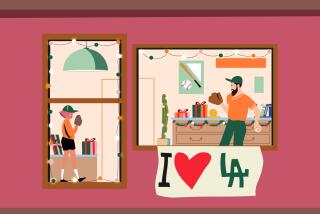Around Home : Notes on Gazebos, Sconces and Teakettles : Paper Making
- Share via
PAPER IS SO much a part of our lives, so taken for granted, so shuffled, filed, wadded and wrapped, that most people don’t realize that it is easy to make your own.
OK: Why would anyone want to?
Homemade paper is wonderfully thick and rough (although it can also be silky and filmy), as textural and personal as a handmade wool sweater. These are not 8 1/2x11 typing sheets but coarse-edged works of art that demand one’s very best handwriting and prose--calligraphy, even. The kind of paper that sells for princely sums in specialty shops, when you can find it.
But you don’t have to write on it; some artists sculpt paper, and people have been known to wear it.
Egyptians mashed papyrus for their writing material, but modern paper making began in China in AD 105, when a court official named Ts’ai Lun ground up mulberry fibers with rags, old fishnets and other plant fibers, soaked the resulting mess in water, filtered the pulp over a screen to drain off excess water, then let the paper dry. That is essentially the same process used today in manufacturing commercial or handmade paper.
To make paper at home, the only equipment needed is a blender for making paper-and-water slush and a wire-mesh frame for draining. But spare the tree; use waste paper, such as grocery bags or junk mail--preferably not slick paper with color printing--or plant fibers from the garden (banana, iris, thistles, corn, asparagus). Homemade paper can also be dyed or bleached. And it will be unique; no plain white bond can come close to making the same impression. The only problem: thinking up a message important enough for such terrific-looking paper.
For a free brochure with detailed paper-making instructions, write to the American Paper Institute, 260 Madison Ave., New York, N.Y. 10016.
The Paper Source, Los Angeles, stocks fibers, sizing, dyes and mesh frames. Classes in paper making occasionally are offered at craft shops and museums in Southern California.
Handmade paper and other paper objects are sold at Free Hand in Los Angeles, Del Mano Gallery and Studio in West Los Angeles, Oggetti in Century City; Gallery 8 in La Jolla and Running Ridge in Ojai.
Fiberarts magazine has featured the paper artistry of many crafts people. A Fiberarts subscription costs $21 per year for six issues; the address is 50 College St., Asheville, N.C. 28801.






